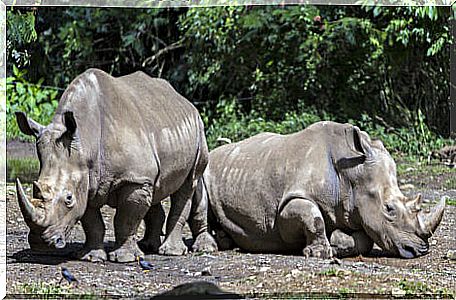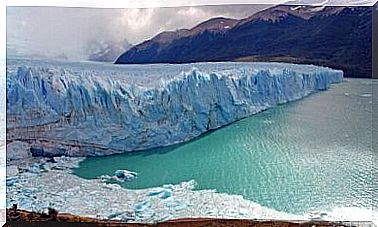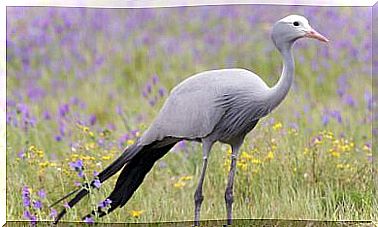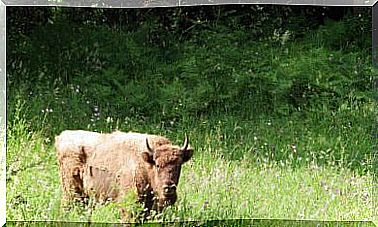The Java Rhinoceros: Why Is It In Danger Of Extinction?

In the past, rhinos were common animals that could be found throughout most of the Old World, but since the 20th century, their numbers have plummeted. For this reason, very few specimens can currently be found outside of national parks or reserves: the Javan rhinoceros is a clear example of this decline.
Of the 5 rhino species that survive today, 3 are critically endangered and the status of the other 2 is far from ideal. This means that, within a few generations, rhinos could disappear from the planet.
The Javan rhinoceros is one of the most endangered rhinoceros species. We invite you to continue this reading if you would like to learn more about this elusive mammal and its conversational state.
The State of the Java Rhinoceros
Rhinoceros sonoicus is possibly the scarcest rhinoceros on Earth and one of the largest rarest mammals in the world. It is lighter and smaller than other rhinos and is characterized by its unique horn and folded skin in the shape of armor plates.
Previously, this animal could be found in much of Southeast Asia and had 3 subspecies : Rhinoceros probeicus inermis, Rhinoceros probeicus annamiticus and Rhinoceros probeicus probeicus.
LOL. inermis inhabited India, Bangladesh and Myanmar, and R. s. annamiticus lived in countries like Vietnam, Laos, Cambodia and Thailand. Unfortunately, both subspecies have gone extinct in recent decades.
LOL. probeicus is the only one that still survives, but it is also severely damaged. This animal used to inhabit Thailand, Malaysia and the Indonesian islands of Java and Sumatra. Now he remains only on a small peninsula on the island of Java.
The most recent estimates suggest that there are about 74 individuals of Javan rhinoceros, all in Ujung Kulon National Park. However, only 33% of specimens are reproductive, which hinders the development of this population.
Currently, it appears that the population has managed to stabilize and increase slightly thanks to intense conservation efforts. However, this animal still presents very serious threats that can stop and even reverse this growth.

How did the rhinoceros get to this point?
As with most endangered species, the current decline of the Java Rhinoceros was caused by human actions and is an example of the current process of mass extinction.
One of the first threats to this animal was the arrival of European settlers in Southeast Asia, from which its indiscriminate hunting as a trophy began. He was also hunted for the benefit of local agriculture and obtaining his horns.
As with many other species, the trade in horns and other products used in traditional Asian medicine has been a major driver of its population decline.
Poaching has extinguished populations of R. probeicus in most of its distribution. In fact, the last rhinoceros in Vietnam was killed by poachers in 2010. Today the horn trade is illegal and fought, but it remains a significant threat.
Along with this, the destruction of suitable habitats has been another negative factor. This mammal is sensitive to human disturbance and needs low-lying rainforests to survive. These habitats become increasingly scarce as they are replaced by plantations.
Current Threats of the Java Rhinoceros
Fortunately, there have been no cases of poaching in Ujung Kulon National Park in the last 20 years. However, trafficking is still a very prevalent problem that requires constant vigilance, although the horns have no proven medicinal effect.
Trafficking is linked to poverty, which makes it difficult to eradicate hunting while there is demand. Rhinoceroses live in very poor countries, where locals resort to poaching to meet their basic needs. Therefore, the solution requires profound social and economic changes.
Furthermore, the population has barely increased in recent years. This may be due to human intrusion, as the ecosystem has reached its limit carrying capacity and is therefore unable to house any more rhinos.
Ujung Kulon is full of Arenga obtusifolia , a palm tree that covers a lot of ground, which is not consumed by rhinos and prevents the growth of other plants. In addition, the Park contains a large number of bantengue, a native bovine that competes with rhinos for food.
The only existing population is small and highly localized. Therefore, the species has very poor genetic diversity and is prone to inbreeding. This is a big risk for any species.
This situation makes this animal more vulnerable to disappearance due to natural disasters such as tsunamis or volcanic eruptions, which are relatively frequent in the area. It also makes it vulnerable to diseases transmitted by local livestock, which have already killed several individuals.

a little hope
There are conservation plans to improve the status of the Java Rhinoceros, including creating a second population in another area to reduce the aforementioned risks.
In addition, conservationists and local communities are removing Arenga obtusifolia from some areas to create suitable habitats and are working to prevent poaching and other human harm. Despite this, conserving such a damaged species is an extremely difficult task.









